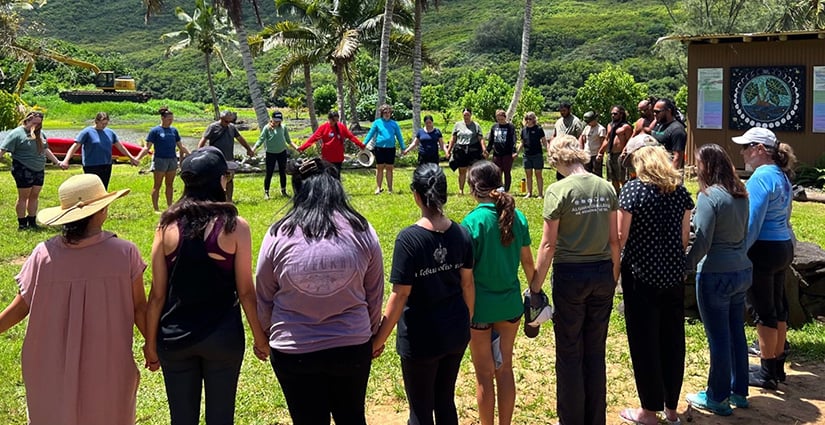Cohort 1: Kauai, Hawaii
Kauai County, Hawaii, conducted data analysis, modeling, and surveys to study ways to improve the island's transportation system with technical assistance from the Energy Technology Innovation Partnership Project (ETIPP).

An ETIPP project in Kauai, Hawaii, involved surveying residents and visitors about their transportation preferences. Photo from Christina Kaser, County of Kauai
Project Summary
 Population Size
Population Size
73,294
 Technology Focus
Technology Focus
Mobility, emerging transportation technology, electric vehicles
 Lead Lab
Lead Lab
National Laboratory of the Rockies
 Regional Partner
Regional Partner
Kauai's transportation system and tourism-centered economy depend heavily on automobiles and petroleum fuels, which creates several resilience challenges for this remote island community. At any given time in a normal year, Kauai has more than 30,000 visitors on-island traveling in rented vehicles; that's almost one visitor for every two residents on the entire island. Visitors are unfamiliar with local conditions and often congregate in large numbers in remote areas of the island. Small roads going in and out of these areas are often the only evacuation routes for the small communities along the Route 50 and Route 56 corridors, which include Hanalei, Kilauea, Anahola, Kapa`a, Koloa, Kalaheo, Hanapepe, and Waimea. In the event of a natural disaster—the frequency and impacts of which are becoming more profound—the high volume of visitor traffic in these areas far exceeds the roadway capacity for rapid and safe evacuation, meaning the Route 50 corridor communities are more vulnerable to natural disasters and congestion.
By analyzing mobility options that can reduce the use of single-occupancy vehicles on the island and best locations for electric vehicle (EV) chargers, Kauai County can help residents and visitors reduce energy costs and become more resilient in the face of the expected increase of weather events and natural disasters. Kauai County's expectation is that providing an affordable, sustainable, and convenient transportation system will make traveling around Kauai less burdensome and boost local business revenues.
Project Outcomes
Surveys and analysis by NLR researchers unearthed a number of key findings during this ETIPP project:
- Driving alone and carpooling were the primary modes of transportation for most residents for commuting, leisure, or shopping activities.
- Sociodemographic and housing characteristics were the major factors that determined mode choice instead of travel time and cost, which indicated that the island's public transit system was not robust enough to compete with driving and was often only considered when driving was not an option.
- Mobility options such as car shares, bike and e-bike shares, and autonomous shuttles have potential to replace driving trips for both residents and visitors.
- Of the visitors to the island, 74% rented a car. And more than 50% of those visitors researched alternative transportation options.
- Only half of those that rented a car drove it every day. However, more than 80% of visitor respondents indicated they would consider taking a shuttle from the airport to their hotel and renting a car for the portion of the trip only when a car is necessary.
- Offering discounts on lodging has potential to encourage public transit use among visitors.
Key Takeaways
Both Kauai residents and visitors rely heavily on driving to get around on the island. This study highlighted the lack of alternatives as a primary reason for auto dependency and identified that competitively priced, convenient mode alternatives have the potential to reduce car use. A sustainable transportation pathway was proposed for Kauai, anchored by robust transit corridors and supported by alternative transportation modes, such as micromobility, on-demand transit, flexible car rental options, and parking restrictions in urban centers. App-based data was used to study travel patterns of residents and visitors to identify high-demand transit corridors. Furthermore, locations with high volumes of short trips were identified as potential replacement by nonmotorized modes. The path and decision process from this study provided valuable insights for developing sustainable transportation systems in other tourism-dependent island communities.
Opportunities and Impacts
Kauai County is engaging in follow-up meetings with project partners that supported outreach application support, making data connections, providing insight and feedback in working groups, and supporting the transportation preferences survey. The county hopes to explore pathways to practically use the ETIPP findings on Kauai's transportation projects moving forward.
Additional Resources
Kauai Partners With NLR To Explore Sustainable Transportation Options, NLR News (2024)
Hawaii Natural Energy Institute Research Highlights, Hawaii Natural Energy Institute (2023)
Schatz: Kauai and Honolulu Selected To Participate in Energy Department Program To Help Transition to Resilient Clean Energy Solutions, U.S. Senator for Hawaii Brian Schatz (2021)
Share
Last Updated Dec. 7, 2025
